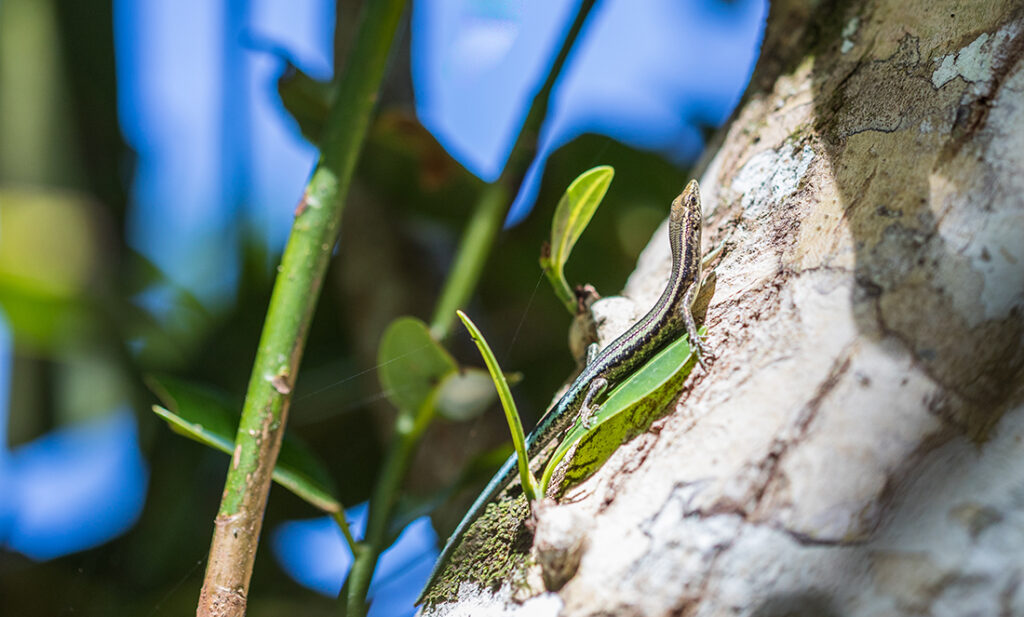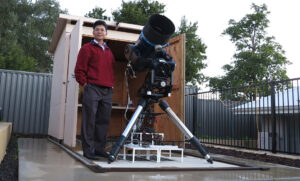The 13,500 hectare island lies 2600km northwest of Perth and 350km south of Indonesia in the Indian Ocean.
Christmas Island’s biodiversity is internationally recognised, with many plants and animals found nowhere else on the planet.
ONE LIZARD LOST, TWO SAVED
Some endemic species are struggling to cope with introduced predators such as snakes, cats, giant centipedes and yellow crazy ants.
The last known Christmas Island forest skink, nicknamed Gump, died in captivity in 2014.
The species is believed to be the first Australian native reptile to be lost forever.
The Lister’s gecko and the blue-tailed skink were nearly wiped out too, but a pioneering conservation programme has brought them back from the brink.
A WOLF AT THE DOOR
Lister’s geckos and blue-tailed skinks were once widespread, but their numbers have plummeted since the 1990s.
The tiny reptiles weigh less than a 5 cent piece as adults and the same as a paperclip when they are born.
The Southeast Asian wolf snake is believed to be responsible for their dramatic decline, Christmas Island National Park field programme coordinator Brendan Tiernan says.
“The decline in the reptiles seems to match the spread of the wolf snake,” he says.
“It’s very quick and very efficient in demolishing them.”
The snake is thought to have invaded the island by boat.
SAFEGUARDING THEIR SURVIVAL
To prevent wolf snakes snacking on the lizards, 66 blue-tailed skinks and 43 Lister’s geckos were captured in 2009 and 2010.
They hadn’t been kept in captivity before, but by May this year, their numbers had soared to 1473 skinks and 804 geckos in captivity on Christmas Island and at Sydney’s Taronga Zoo.

The zoo’s reptile experts also provide advice about managing the lizards to avoid inbreeding.
The programme’s goal is to reach 5000 of each species by 2024 to retain genetic diversity.
Brendan says the programme has exceeded expectations, but there’s still work to be done to ensure the species can survive without human help.
Blue-tailed skinks took the first step towards returning to the wild in April when they were released into a 1/4 hectare snake-free enclosure.
Brendan says it’s early days but results are positive.
WA LENDS A HELPING HAND
UWA’s Jon-Paul Emery is keeping a watchful eye on the blue-tailed skinks.
“Not much is known about the behaviour, habitat and diet preferences of the skink in the wild,” Jon-Paul says.
“Monitoring this trial is a great opportunity to advance our understanding of this species and will be valuable for identifying potential future release sites.”
Hopefully, the skinks thrive and Lister’s geckos can follow in their footsteps in the future.

CAN THEY EVADE THE INVADERS?
The Cocos Keeling Islands, about 1000km west of Christmas Island, are being investigated as a potential safe haven.
Translocating captive-bred skinks could offer a solution to the wolf snake problem, Brendan says.
“No one’s ever successfully eradicated an invasive snake from the wild,” he says.
“We don’t doubt that it’s going to be a hard job to try and do that on Christmas Island.”
The National Environment Science Programme (NESP) supports conservation on the island by funding research projects through the Threatened Species Recovery Hub.












